
Mihran Mesrobian was an Armenian-American architect whose career spanned over fifty years and in several countries. Having received an education in the Academy of Fine Arts in Constantinople, Mesrobian began his career as an architect in Smyrna and in Constantinople. While in Constantinople, Mesrobian served as the palace architect to the last Ottoman Sultan, Mehmed V.
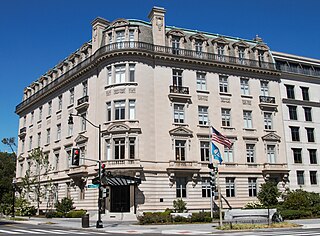
McCormick Apartments, also known as Andrew Mellon Building, Mellon Apartment, or 1785 Massachusetts Avenue Northwest, is a landmark apartment building on Embassy Row in Washington, D.C., whose inhabitants once included Andrew W. Mellon. It is the home of the American Enterprise Institute.

The William E. Borah Apartment at Windsor Lodge is a historic apartment in a 16-unit apartment building at 2139-2141 Wyoming Avenue NW in Washington, D.C. Apartment 21 in the building was a long-time home of William Edgar Borah (1865–1940), a U.S. Senator from Idaho and a candidate for president in 1936. Borah was a leading figure in American foreign policy in the years after World War I, contributing to the American non-acceptance of the League of Nations and the acceptance of the Washington Naval Treaty of the early 1920s. This apartment is the best-preserved surviving residence of Borah; for its association with his life, the entire building was designated a National Historic Landmark in 1976.
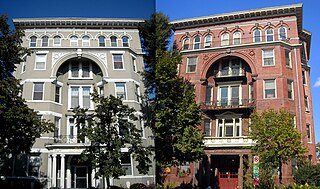
The Gladstone and Hawarden Apartment Buildings are historic twin buildings located in the Logan Circle neighborhood of Washington, D.C. Built in 1900 and 1901, the Gladstone and Hawarden are early examples of middle class apartment buildings in the city. They were designed in the Romanesque Revival architectural style by prominent local architect George S. Cooper. The buildings, since converted into condominiums and a housing cooperative, were added to the National Register of Historic Places (NRHP) in 1994.

The Fraser Mansion is a building at 1701 20th Street NW, at the intersection of Connecticut Avenue, 20th Street, and R Street in the Dupont Circle neighborhood of Washington, D.C. constructed in 1890 to be the George S. Fraser mansion, it served as his private residence for five years, a restaurant, a boarding house, the home of the new Founding Church of Scientology, and—currently—the location of Scientology's National Affairs office.

Wyoming Apartments is a historic apartment building, located at 2022 Columbia Road, Northwest, Washington, D.C. in the Kalorama neighborhood.

The Roosevelt Apartment Building is an historic structure located in the Capitol Hill neighborhood in the Northeast quadrant of Washington, D.C.

Hampshire Garden Apartment Buildings are historic structures located in the Petworth neighborhood in the Northwest quadrant of Washington, D.C. They were listed on the National Register of Historic Places in 1994. It is also a D.C. Historic Landmark.

Hilltop Manor, now known as The Cavalier, is an historic structure located in the Columbia Heights neighborhood in the Northwest Quadrant of Washington, D.C. This building is one of several developments between architect Harvey H. Warwick and developer Morris Cafritz, and is one of the first cooperative apartment buildings in the city. The building was opened in 1927 along the 14th Street streetcar line. Its size and density shows the rapid growth Washington experienced along major thoroughfares after World War I. It was listed on the National Register of Historic Places in 2007.

The Lafayette Apartment Building is an historic structure located in the Shaw neighborhood in the Northwest Quadrant of Washington, D.C. George S. Cooper was the architect for this building, which was one of the earliest apartment buildings in Washington. Built in 1898 it incorporated elements of the Queen Anne style into an affordable middle-class development. It was listed on the National Register of Historic Places in 1994.

The Whitelaw Hotel is a historic structure located in the U Street Corridor in Northwest Washington, D.C. It was listed on the National Register of Historic Places in 1993.

The Cathedral Mansions Apartment Buildings are historic structures located at 2900, 3000, and 3100 Connecticut Avenue NW in the Woodley Park neighborhood of Washington, D.C. Constructed from 1922 to 1924, architect Eugene Waggaman designed the Connecticut Avenue apartment buildings in the Classical Revival style for developer Harry Wardman. Architect Mihran Mesrobian's initials appear on a drawing for one of the buildings.

The Augusta Apartment Building, along with the Louisa Apartment Building, are historic structures located in the Northwest Quadrant of Washington, D.C. Washington architect Arthur B. Heaton designed both buildings, which were built a year apart from one another in 1900 and 1901. They are two of his earliest commissions. The Tudor Revival façade of the buildings emulate the mansions that were built during the late Victorian age. The exterior features Flemish bond and tapestry brick with decorative motifs in both tile and limestone. It was listed on the National Register of Historic Places in 1994.

The Bachelor Apartment House is an historic structure located in the Northwest Quadrant of Washington, D.C. The architectural firm of Wood, Donn & Deming designed the building.
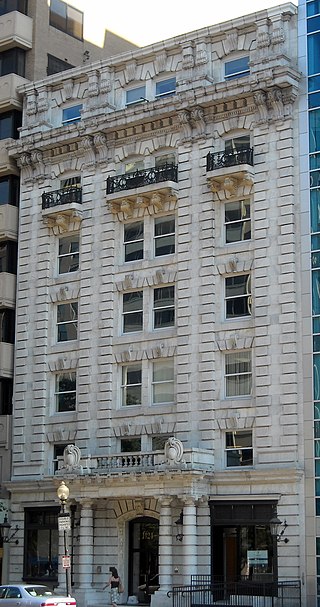
The Champlain Apartment Building, also known as the Orme Building, is an historic structure located at 1424 K St., Northwest, Washington, D.C. in the Downtown neighborhood.
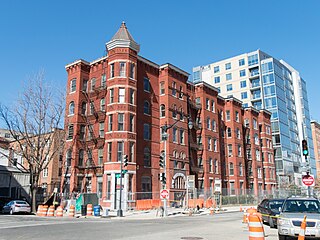
Harrison Apartment Building is an historic structure located in the Chinatown neighborhood of Washington, D.C. The building is the oldest known surviving conventional apartment building in the city.
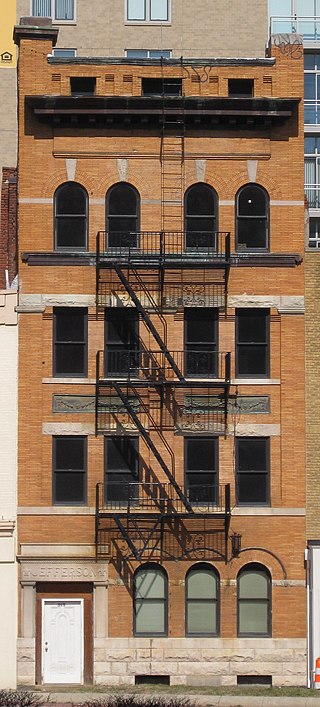
The Jefferson Apartment Building is an historic structure located in the Mount Vernon Triangle neighborhood of Washington, D.C. The small middle-class apartment building was designed by George S. Cooper, who was a prolific apartment architect in the city. The structure features a Romanesque Revival façade. It was listed on the National Register of Historic Places in 1994.
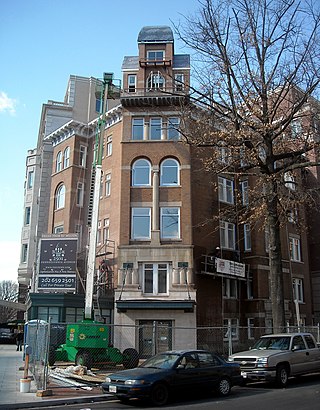
The Luzon Apartment Building, also known as The Westover, is an historic structure located in the West End neighborhood of Washington, D.C. The building is one of the last surviving structures from the formative period of apartment buildings in the city. The Romanesque Revival building was designed by Nicholas T. Haller and completed in 1896. It was listed on the National Register of Historic Places in 1994.

Madison Hall, formerly known as the Flagler Apartments, is a residence hall on the campus of George Washington University (GW) in Washington, D.C. The building was designed by Stern and Tomlinson and was built in 1926. The building is representative of the apartment buildings that were built from the 1920s to the 1940s that have been acquired by the university and converted into dormitories. GW bought the building in 1957 and replaced its manually operated elevators during its renovations. The building was named for both James Madison and Dolley Madison. It was listed on the District of Columbia Inventory of Historic Sites and the National Register of Historic Places in 2010.

Mount Vernon Triangle is a neighborhood and community improvement district in the northwest quadrant of Washington, D.C. The neighborhood is located adjacent to Mount Vernon Square. Originally a working-class neighborhood established in the 19th century, present-day Mount Vernon Triangle experienced a decline in the mid-20th century as it transitioned from residential to commercial and industrial use.





















